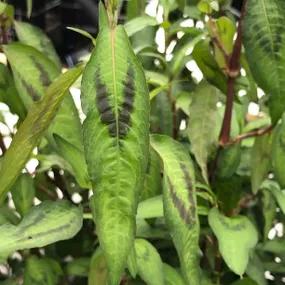Vietnamese Coriander Plants
The details
Persicaria odorata
- Packs of 3 Plants
- Height: 30cm
- Spread: 20cm
- Colour: Green with dark markings
- Flowers: Rarely in the UK
- Uses: culinary
- Taste: Strong coriander
- Harvest: Summer months outdoors (all year indoors)
- Spacing: 30 cm
- Life: Treat as a half-hardy annual outside
Recommended extras
Description
Vietnamese Coriander / Hot Mint Plants
Vietnamese coriander, also called Vietnam or hot mint, is not related to either plant, and is used in traditional cuisine across Southeast Asia. The leaves are bright green, spear shaped, developing a distinctive V marking with maturity, and a reddish joint at each leaf node. Once it has settled in, it grows vigorously.
Features
- Height: 30-40cm (can grow taller if you don't harvest it)
- Spread: 30 cm
- Uses: culinary, salads, tea
- Harvest: all summer (all year if grown indoors)
- Spacing: 30 cm
- Life: treat as half-hardy to tender annual outside. Grow as a perennial indoors.
Growing Vietnamese Coriander
This tender treat can't cope with a British winter (maybe in Cornwall), so most people grow it in a container and bring it inside as the nights begin to cool. It loves a sunny kitchen window sill: the more warm and humid, the better. It needs full sun and constant moisture, but it doesn't like a waterlogged soil.
To keep it nice and bushy, you need to pinch out the growing tips regularly: let it establish for about a month before you begin to harvest it. Feed twice a month with a liquid seaweed based fertiliser; a little goes a long way, and too much will impair the flavour.
They can easily be propagated from cuttings in the same way as mint. It tends not to flower in the UK, but if any flowers appear, snip them off.
Using Vietnamese Coriander in the Kitchen
This tip applies to most herbs: harvest them when they are dry, ideally at the end of a sunny day.
It has a strong taste, so you use it sparingly. For culinary uses, the juvenile (unmarked) leaves are the best. It tastes like a supercharged Coriander, leaving a trail of warmth from your tongue to your belly.
It is versatile, so try it chopped in salads, stir fries, and as a tea. It goes well with Lemongrass, and you should always think of it in dishes where you use lime or lemon juice.
Did You Know?
Its local Asian names are rau ram in Vietnam, daun kesom or daun laksa (laksa leaf - you often see this name on restaurant menus) in Malaysia and Singapore, and pak pai in Thailand. Its former botanical name was Polygonum odoratum.
This plant is an anti-inflammatory that helps digestion, and is stuffed with antioxidants. It is high in beta-carotene, calcium, iron, and vitamin E.


